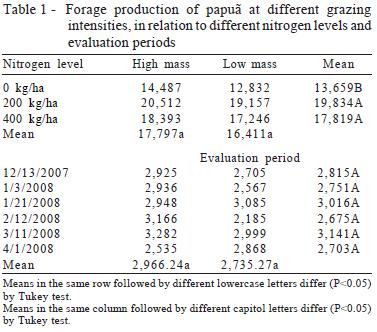This work aimed to evaluate the effects of grazing intensities and nitrogen fertilization levels on the dynamics of a Brachiaria plantaginea pasture. The experiment was laid out as a random block design, in a 3 × 2 factorial scheme, composed of three nitrogen levels (0, 200 and 400 kg/ha nitrogen in urea form) and two grazing intensities termed low mass (LM; forage mass of 1500 kg of DM/ha) and high mass (HM; forage mass of 3000 kg of DM/ha) in a continuously stocked swards with two replications. Animals used were half-blood Boer goats averaging five months old and 21 kg body weight (BW) for adjustment of the target forage mass. Real forage mass, average height of the plants and animal stocking rates were of 2,567 and 3,862 kg DM/ha; 23.6 and 31.2 cm and 2,804 and 2,089 kg BW/ha respectively for low and high mass. Accumulation rate was of 100, 147 and 132 kg DM/ha/day and total production 13,659; 19,834 and 17,820 kg DM/ha, respectively to the 0, 200 and 400 kg N/ha. There were no differences on pasture yield among grazing intensities suggesting that higher stocking rates can be used. The level of 200 kg N/ha promotes the best response on papuã grass pastures. Papuã grass shows high yield, good production distribution during the plant cycle and excellent nutritional value.
Brachiaria plantaginea; forage production; forage nutritive value; forage sward; reseeding; stocking rate






